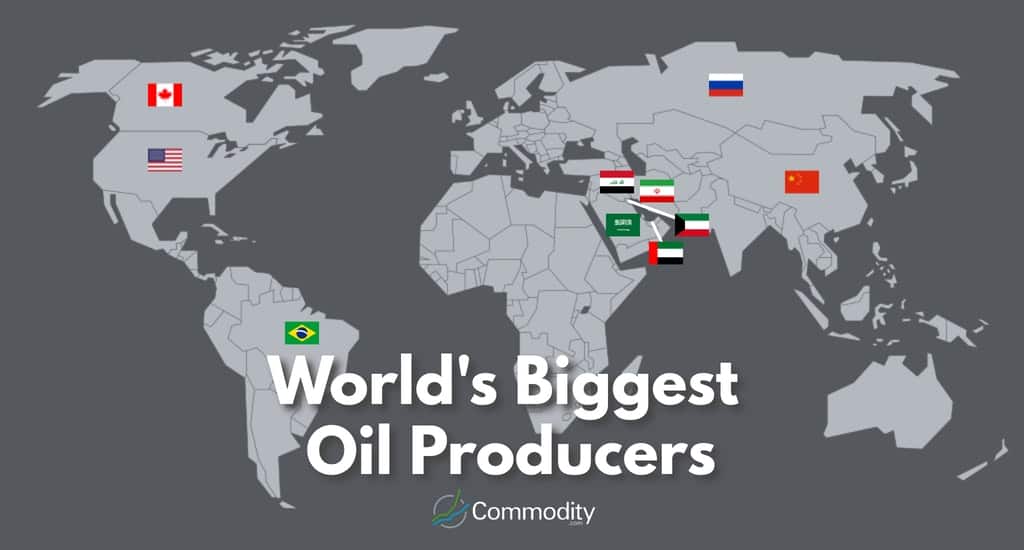Crude oil is the world’s primary energy source — the backbone of transportation as well as electricity generation, which powers almost every aspect of our lives.
In this guide to understanding crude oil, we’ll explain why it’s valuable, discuss its history, describe how it’s produced, and explain what drives its price. We also answer some common questions about this crucial energy commodity.
Interested in how oil is traded? See our full guide, or if you want to start trading right now, here are options available in to consider:
Contents
What Makes Crude Oil Valuable?
Crude oil is naturally occurring unrefined petroleum. It is mostly composed of hydrocarbon deposits. It’s a finite resource that can be refined to produce everyday products like gasoline, diesel fuel, and petrochemicals for plastics.
See today’s live Brent crude and WTI crude oil prices in our Oil Price Guide. You can also use technical analysis tools and oscillators to aid your trading.
Before the Industrial Revolution, agricultural staples like corn and wheat ruled the commodities market. Today, however, crude oil and derivatives like crude oil CFDs are the most actively traded commodities in the world.
Oil interacts with most aspects of the global economy as a consumer good, as well as raw material for production and transportation.
Aside from fuel to power vehicles, oil is a major component in the manufacturing of:
- Plastics
- Synthetic textiles (acrylic, nylon, spandex, polyester)
- Fertilizer
- Computers
- Cosmetics.
How Much Oil Is Used Per Day?
As of 2019, the average American uses approximately three gallons of petroleum products per day.
A 42-gallon barrel of crude oil produces roughly 45 gallons of petroleum. Of this, most is used to create different kinds of fuel sources with roughly 13% going to produce consumer products.
West Virginia consumes more than 1,000 trillion BTUs of fossil-fuel derived energy. It is also the third-highest producer of fossil fuel energy in the US.
A Brief History of Oil
Oil didn’t become a significant factor in human history until the mid-19th century but has become intrinsic to our modern way of life.
| 1775 | English colonies in North America begin using kerosene, a petroleum product, instead of whale oil for lighting, grease, and medicine |
| Mid-late 1800s | First oil well built and world’s first oil pipeline opens |
| Early 1900s | Massive oil geyser is discovered in Spindletop, TX, producing almost 100,000 barrels a day. Invention of Bakelite, a plastic made from petroleum. |
| 1931 | Great Depression causes oil prices to plummet |
| 1941 | US enters World War II, accelerating plastics production |
| 1960 | Organization of Petroleum Exporting Countries (OPEC) formed |
| 1972 | First recycling mill for residential plastics opens |
| 2000s | Toyota launches Prius hybrid car. Tesla Motors releases all-electric car, the global financial crisis begins, and OPEC enacts first production cut. |
| 2020 | COVID-19 pandemic sends the price of crude oil into negative numbers |
| 2021 | Oil prices recover to pre-pandemic figures above $80 per barrel |

Image via Pixabay (license).
Brent vs WTI: Crude Oil Blends
Although the market for oil is global, oil trading has clustered around several primary regions.
Brent and West Texas Intermediate (WTI) are two of the biggest internationally recognized oil blends. Both are used as price indicators on the oil market and define oil prices based on two key differences — location, and therefore quality.
Depending on where oil is sourced, the core qualities of the liquid, like density, mineral composition, scent, are likely to differ. This creates a difference in value, as indicated by the labels of Brent and WTI.
The name ‘Brent’ comes from the Brent Oilfield on the Scottish coast, the second-ever UK oilfield to be developed. Meanwhile, ‘West Texas Intermediate’ comes from the Permian Basin that’s located in North America between Texas and New Mexico, an area rich in oil.
Note that Texas produces the most oil out of all US states with over 1.7 billion barrels each year, boasting an oil reserve of more than 18 billion barrels.
Here is a direct comparison between Brent crude oil and WTI oil:
| Brent Crude Oil | WTI Oil | |
| Extraction Location | North Sea (seas by the UK and Scandinavia) | North Sea (Permian Basin, Texas) |
| Refinery Location | Northwestern Europe | Midwest (US), Gulf of Mexico |
| Density & Quality | Light and sweet (low sulfur content) | Light and sweet (low sulfur content) |
| Financial Products & Exchanges | Brent crude futures on ICE and NYMEX | WTI futures on NYMEX |
Both Brent and WTI have low sulfur content, an important factor for high-quality crude oil. Both come from the North Sea regions, though at different latitudes. Despite these similarities, Brent crude and WTI crude oil have different refinery processes and supply chains before reaching commercial and retail clients.
Some consider WTI a better quality due to its historically lower sulfur content, although this is not always reflected by market spot prices.
Explore live and historical crude oil prices with technical indicators and analysis tools in our Crude Oil Price Guide.
Other Crude Oil Types
The crude oil in each of the below geographies has slightly different characteristics, typically referred to in terms of viscosity (light versus heavy) and sulfur content (sweet versus sour).
Each of the major trading regions has established benchmarks to track price movements in oil commodities. Here are the other main crude oil blends alongside Brent and WTI.
| Crude Oil Name | Region | Viscosity | Sulfer Content | Description |
|---|---|---|---|---|
| West Texas Intermediate (WTI) | Texas | Light | Sweet | A light, sweet crude oil, with a gravity of around 40 on the American Petroleum Institute (API) gravity scale and low sulfur content. |
| Brent Crude | North Sea | Light | Sweet | A light, sweet crude oil from the North Sea. Its gravity is similar to WTI, but its sulfur content is slightly higher. From an oil trading point of view, it’s closest in quality to WTI. |
| Bonny Light | Nigeria | Light | Sweet | A light sweet crude from Nigeria that’s useful as a benchmark for African oil. Its properties are similar to WTI and Brent, and in fact, demand for Bonny Light is primarily driven by European and American oil refineries. |
| Dubai Crude | Middle East | Medium | Sour | Also known as Fateh, is denser (heavier) than both WTI and Brent and has a higher sulfur content, making it a sour crude. It’s useful in oil trading as a benchmark for oil shipments in the Middle East. |
| OPEC Reference Basket | Middle East | Heavy | Sour | A weighted average of the mix of crudes produced in the OPEC region. It is heavier than both WTI and Brent. |
| Urals | Russia | Heavy | Sour | A heavy sour crude representative of Russia’s oil exports. |

Which Countries Produce the Most Oil?
| Rank | Country | Flag | Oil Production (Millions of barrels per day) |
|---|---|---|---|
| #1 | USA | 19.51 | |
| #2 | Saudi Arabia | 11.81 | |
| #3 | Russia | 11.49 | |
| #4 | Canada | 5.50 | |
| #5 | China | 4.89 | |
| #6 | Iraq | 4.74 | |
| #7 | UAE | 4.01 | |
| #8 | Brazil | 3.67 | |
| #9 | Iran | 3.19 | |
| #10 | Kuwait | 2.94 |
Note that these numbers include crude oil, other petroleum liquids, and biofuels. Source: US Energy Information Administration.
Top Countries by Oil Reserves
| Rank | Country | Flag | Proven Reserves (millions of barrels) |
|---|---|---|---|
| #1 | Venezuela | 301,000 | |
| #2 | Saudi Arabia | 266,000 | |
| #3 | Canada | 170,000 | |
| #4 | Iran | 158,000 | |
| #5 | Iraq | 143,000 | |
| #6 | Kuwait | 102,000 | |
| #7 | UAE | 98,000 | |
| #8 | Russia | 80,000 | |
| #9 | Libya | 48,000 | |
| #10 | USA | 35,000 |
Source: US Energy Information Administration
Crude Oil vs Natural Gas
Sometimes crude oil is confused with natural gas. They have similarities but are fundamentally different commodities.
Both crude oil and natural gas are flammable, nonrenewable energy sources found underground. Here are the main differences:
- Crude oil: Also called petroleum, crude oil is drilled in liquid form. One of the products created from crude oil is gasoline.
- Natural gas: Found in gas form alongside crude oil, composed mostly of methane.
Gasoline used to fuel cars, is sometimes referred to as “gas” for short, despite the fact that it’s a liquid.
To find out more about natural gas as a commodity, read our natural gas page or learn how to trade natural gas.
Regulated Brokers: Where Can I Trade Crude Oil?
Start your research with reviews of these regulated brokers available in .
CFDs are complex instruments and come with a high risk of losing money rapidly due to leverage. Between 74%-89% of retail investor accounts lose money when trading CFDs. You should consider whether you can afford to take the high risk of losing your money.
IMPORTANT: CFDs are not available in the USA.
Further Reading
- Learn How to Trade Crude Oil
- Guide to Crude Oil Prices
- Learn to Trade Energy Commodities
- Find a Commodities Broker
FAQ
Below we answer some common questions about crude oil.
How is crude oil formed?
Crude oil is composed of carbon and hydrogen from animals and plants that died between the Paleozoic and Mesozoic eras — the period from roughly 541 million to 65 million years ago. These organic remains combined with rocks, mud, heat, and pressure over millennia became what we now call “fossil fuels.” Coal and natural gas are also considered fossil fuels.
Where does crude oil come from?
Crude oil can be found in various parts of the world including North and South America, Asia, and the Middle East. The oil comes from deep in the earth or at the bottom of the ocean. Some off-shore ultra-deep oil platforms can drill up to 1,500 meters beneath the surface.
What is crude oil used for?
Crude oil can be refined to perform many different functions — including fuel for vehicles, kerosene, heating oil, asphalt, waxes, lubricants, synthetics, and plastics. Crude oil can also be used to create chemicals that go into making synthetic rubber, dyes, detergents, and fibers.
Credits: Original article written by Lawrence Pines . Major updates and additions in May 2020 by Natalie Mootz with contributions from the Commodity.com editorial team.


